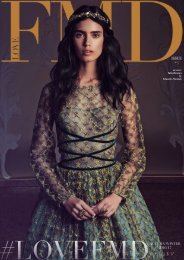loveFMD Magazine issue3
loveFMD is a unique and versatile magazine providing full elegancy from the world of fashion. With a pressing mix of the finest in fashion, beauty and style it focuses on concepts and ideas presented in a differentiated and sophisticated form.
loveFMD is a unique and versatile magazine providing full elegancy from the world of fashion. With a pressing mix of the finest in fashion, beauty and style it focuses on concepts and ideas presented in a differentiated and sophisticated form.
Create successful ePaper yourself
Turn your PDF publications into a flip-book with our unique Google optimized e-Paper software.
INTRODUCING | THE GENIUS OF HEDI SLIMANE<br />
One of the things that sets Slimane apart<br />
from other designers is his vision, and that<br />
everything he does represents his vision<br />
so perfectly. He is one of the rare few designers<br />
that one could call a ‚Visionary‘<br />
who‘s equally, if not more, comfortable<br />
foraying the worlds of music, art and interior<br />
design. Then there is the perfection<br />
of each individual garment, the almost<br />
magnetic sense of desirability his clothes<br />
inspire when you see them in a store. Karl<br />
Lagerfeld of Chanel who indelibly lost 90<br />
lbs. in weight in order that he could adopt<br />
Slimane‘s new skinny silhouette, aptly<br />
described the genius of Slimane saying,<br />
„Hedi‘s attitude is right and what he does<br />
and designs is about attitude. From his<br />
generation, he expresses modernity better<br />
than any other menswear designer. But he<br />
is much more than a designer. He has an<br />
eye for total modernity. Photography and<br />
design are part of that. His vision is totally<br />
now in the three different, but not so different,<br />
areas. And few designers have more<br />
than a double vision of what is going on<br />
and know how to translate it into designs<br />
and images.“<br />
While it is true that he has designed for<br />
only two fashion houses, Saint Laurent<br />
and Dior, Slimane has a stranglehold on<br />
the fashion industry today with his shadow<br />
still looming large over menswear. While<br />
his design influence is still evident years<br />
after his first Dior Homme collection, in the<br />
past few years, his work has been subject<br />
to interpretation and appropriation with<br />
his clothes and his methods been copied<br />
wholesale by many other designers. His<br />
post fashion life has not gone unnoticed<br />
and the multi-hyphenate has also reinvented<br />
himself as a photographer, producing<br />
an array of strikingly intimate portraits that<br />
has and are almost as popular as the fashion<br />
houses he‘s overhauled themselves.<br />
Slimane is synonymous to being a rock<br />
star more than almost anyone else in the<br />
fashion world. It is often said that he has<br />
transformed the male silhouette with a<br />
deep affinity for Music that reverberates<br />
through all of his work. His aesthetic is reminiscent<br />
of the punk scene with his role<br />
in styling the likes of Mick Jagger and Jack<br />
White, but at the same time less of the<br />
rebellion of those times and more of the<br />
music associated with it. And it’s not hard<br />
to see why, given that he spent his Paris<br />
childhood in the ‚70s and ‚80s worshiping<br />
David Bowie and the Rolling Stones. The<br />
8 | <strong>loveFMD</strong>.com<br />
extent to which this transformation has<br />
affected the general public and the bottom<br />
line of LVMH is debatable. Slimane’s<br />
menswear lines have drawn on the sartorial<br />
style of various movements in rock music,<br />
chief among them the revival of British<br />
guitar rock. In turn, the bands that inspired<br />
Slimane ended up wearing his clothes:<br />
(newer acts like Razorlight and Franz Ferdinand)<br />
while old-timers like Bowie and<br />
Jagger have become friends as well as<br />
clients.<br />
As singular as his fashion design Slimane<br />
also has an intimate, unscripted photographic<br />
style. His photo work rock portrait<br />
photography in particular, often portrays<br />
musicians at the fringes of fame or notoriety:<br />
up-and-coming artists whose bona<br />
fides lie primarily in the independent<br />
music scene. Artists like Amy Winehouse<br />
and Pete Doherty achieved widespread<br />
renown. Slimane attributes his longstanding<br />
fascination with androgyny in part to<br />
the ambiguities in his first name (pronounced<br />
with a silent „h“ - Edi Sli-man), As a<br />
student, the French-born, Italian-Tunisian<br />
(born in Paris in 1968 to an Italian mother<br />
and a Tunisian father,) took classes in photography<br />
and studied political science. He<br />
grew up in the Buttes-Chaumont district.<br />
His father, a retired accountant, had been<br />
a boxer in Bordeaux (poids léger, of course),<br />
and he met Hedi’s mother, an Italian,<br />
when she was working as a coat-check girl<br />
in a club in Saint Germain des Près.<br />
In his early teens, Slimane spent summer<br />
vacations with an uncle (his mother’s<br />
younger brother) who lived in Geneva<br />
and had a great influence on him . It was<br />
where he was first introduced to Fashion<br />
and luxury within an artistic and bohemian<br />
environment. Slimane‘s mother also<br />
had a significant influence. She worked<br />
as a seamstress when she came from Italy<br />
to Paris, in the early ‘60s. Her uncle was a<br />
tailor, and her aunt taught her how to sew<br />
and cut without pattern. She used to take<br />
him around as a kid to buy fabrics. While<br />
making clothes was something that always<br />
surrounded him young Slimane did<br />
not care much for it, until he turned 16 and<br />
started to feel the need to design his own<br />
clothes.<br />
Slimane was always interested in journalism<br />
in hopes of becoming a reporter and<br />
photographer on international affairs. But<br />
despite his attempts in political sciences<br />
prep school, it never worked out and he ultimately,<br />
switched his focus to art history.<br />
After high school, he studied art for three<br />
years and then began helping friends on<br />
fashion shoots and shows, as a freelance<br />
art director and casting scout. In the early<br />
nineties, he spent a couple of penniless<br />
but fond years in New York, going to night<br />
clubs with Stephen Gan (who is now the<br />
creative director of Harper’s Bazaar and<br />
the editor of Visionaire).<br />
After studying History of Art at the Ecole<br />
du Louvre, One day, doing fittings for a friend’s<br />
fashion show, Slimane was noticed<br />
by the LVMH fashion consultant and talent-trawler<br />
Jean-Jacques Picart, who on<br />
a hunch hired him as his assistant. Slimane<br />
began working with Picart (responsible<br />
for the success of Christian Lacroix, and<br />
Christophe Girard) in 1992 on an exhibition<br />
that celebrated the centenary of Louis<br />
Vuitton‘s iconic monogram. Having been<br />
making his own clothes since the age of<br />
16, he began there with small steps. Three<br />
years later, Pierre Bergé, [the C.E.O. of Yves<br />
Saint Laurent, and Saint Laurent’s longtime<br />
companion] heard about Slimane, too<br />
and tapped him to be the menswear designer<br />
at Yves Saint Laurent, even though he<br />
had very little experience or training. After<br />
meeting Bergé he was hired and worked<br />
on a little presentation of twenty looks<br />
set in an 18th century French salon. It was<br />
shown to only about five people, including<br />
Suzy Menkes, Carine Roitfeld, Hamish<br />
Bowles, Jim Moore from GQ, and Le Figaro<br />
editors.<br />
After completing his work there in 1995 six<br />
months later, the then 27-year-old Slimane<br />
was named menswear director at Yves<br />
Saint Laurent in 1996, before being made<br />
the men‘s artistic director the following<br />
year. But as speedily as Slimane progressed<br />
in rebuilding the men‘s division into<br />
an indispensable one he left YSL. It so<br />
happened that in 1999, Saint Laurent was<br />
sold to Gucci and Tom Ford who became<br />
the creative director at Gucci, insisted that<br />
Slimane report to him. But reporting to<br />
Tom was not going to happen and while<br />
Bergé objected to the arrangement, and<br />
although Ford offered Slimane his own<br />
line under the aegis of Gucci he resigned<br />
just three years later (after presenting the<br />
Black Tie collection for autumn/winter<br />
2000-2001 in January 2000 - in which he<br />
introduced his new skinny silhouette).










